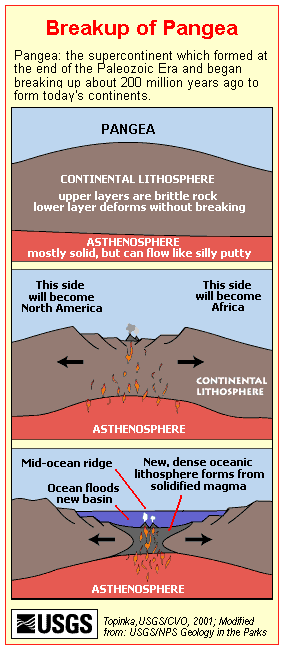
The Breakup of Pangea
From about 280-230 million years ago, (Late Paleozoic Era until the Late Triassic) the continent we now know as North America was continuous with Africa, South America, and Europe. Pangea first began to be torn apart when a three-pronged fissure grew between Africa, South America, and North America. Rifting began as magma welled up through the weakness in the crust, creating a volcanic rift zone. Volcanic eruptions spewed ash and volcanic debris across the landscape as these severed continent-sized fragments of Pangea diverged. The gash between the spreading continents gradually grew to form a new ocean basin, the Atlantic. The rift zone known as the mid-Atlantic ridge continued to provide the raw volcanic materials for the expanding ocean basin.Meanwhile, North America was slowly pulled westward away from the rift zone. The thick continental crust that made up the new east coast collapsed into a series of down-dropped fault blocks that roughly parallel today's coastline. At first, the hot, faulted edge of the continent was high and buoyant relative to the new ocean basin. As the edge of North America moved away from the hot rift zone, it began to cool and subside beneath the new Atlantic Ocean. This once-active divergent plate boundary became the passive, trailing edge of westward moving North America. In plate tectonic terms, the Atlantic Plain is known as a classic example of a passive continental margin.
Sediments eroded from the Appalachian and other inland highlands were carried east and southward by streams and gradually covered the faulted continental margin, burying it under a wedge, thousands of feet thick, of layered sedimentary and volcanic debris. Today most Mesozoic and Cenozoic sedimentary rock layers that lie beneath much of the coastal plain and fringing continental shelf remain nearly horizontal or tilt gently toward the sea.